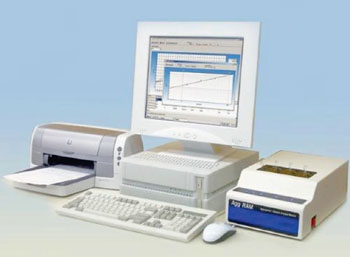Routine Light Transmission Platelet Aggregation Automated
By LabMedica International staff writers
Posted on 05 Aug 2014
Platelet aggregation is most commonly measured by light transmission aggregometry (LTA), in which the increase in light transmission through a stirred suspension of platelet-rich plasma (PRP) is monitored as platelets aggregate.Posted on 05 Aug 2014
The assessment of platelet aggregation to a range of agonists including adenosine diphosphate (ADP), epinephrine, collagen, arachidonic acid and ristocetin is central to the investigation of platelet function disorders, but is only undertaken by a few specialized hemostasis laboratories.
Hematologists at the University College London (UK) working with colleagues from Japan and France, obtained blood samples from 14 normal healthy subjects not receiving any medication or who were self-medicating with nonsteroidal anti-inflammatory drugs, and from 2 individuals who were taking clopidogrel, an antiplatelet agent used to inhibit blood clots. Platelet aggregation was performed by examining the effect of varying reaction cuvette stirrer speed and the platelet count in PRP using the following agonists: ADP, epinephrine, collagen, ristocetin and arachidonic acid. Platelet aggregation reactions were measured on an AggRAM aggregometer (Helena Biosciences Europe; Gateshead, UK) which was used as the reference instrument.
The investigators duplicated the platelet aggregation study using the CS-2000i analyzer (Sysmex Corporation; Kobe, Japan) with the same agonists. The CS-2000i is an open analytical system, which means that test protocols and reagents can be user-defined. For this study, test protocols varying only in the reagent/concentration used were defined for commonly used platelet agonists. These protocols facilitated the generation of measured raw light transmission data under highly controlled conditions including sample volume, incubation period, reagent volume, reaction mixture stirrer speed and period of time for which the reaction was to be monitored.
CS-2000i reaction cuvette stirrer speed was found to influence reaction sensitivity and was optimized to 800 revolutions per minute (rpm). There were no clinically significant changes in aggregation response when the PRP platelet count was 150 to 480 × 109/L, but below this there were changes in the maximum amplitude (MA) and slope (rate). Dose response with each of the agonists was comparable between CS-2000i and an AggRAM aggregometer and normal subjects receiving antiplatelet drugs. Aggregation imprecision was similar on both the CS-2000i and AggRAM systems, with a coefficient of variation for 2 μm to 5 μm ADP MA and slope varying between 3% to 12%.
The authors concluded that their data demonstrated that CS-2000i is comparable to a stand-alone aggregometer, although CS-2000i has the advantages of walk-away technology and also required a 44% smaller sample volume than the AggRAM. The study was published July 13, 2014, in the International Journal of Laboratory Hematology.
Related Links:
University College London
Helena Biosciences Europe
Sysmex Corporation
















